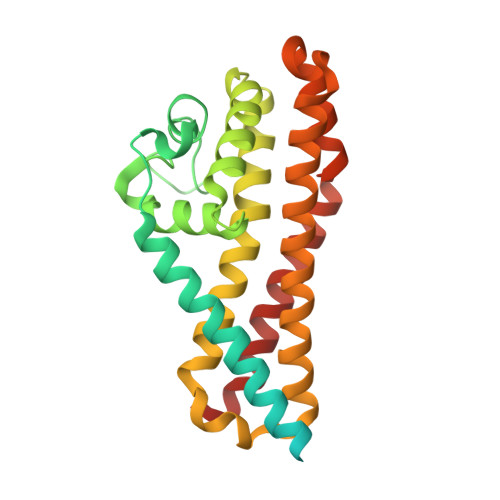Structure of an Outer Surface Lipoprotein Bba64 from the Lyme Disease Agent Borrelia Burgdorferi which is Critical to Ensure Infection After a Tick Bite
Brangulis, K., Tars, K., Petrovskis, I., Kazaks, A., Ranka, R., Baumanis, V.(2013) Acta Crystallogr D Biol Crystallogr 69: 1099
- PubMed: 23695254
- DOI: https://doi.org/10.1107/S0907444913005726
- Primary Citation of Related Structures:
4ALY - PubMed Abstract:
Lyme disease is a tick-borne infection caused by the transmission of Borrelia burgdorferi from infected Ixodes ticks to a mammalian host during the blood meal. Previous studies have shown that the expression of B. burgdorferi surface-localized lipoproteins, which include BBA64, is up-regulated during the process of tick feeding. Although the exact function of BBA64 is not known, this lipoprotein is critical for the transmission of the spirochete from the tick salivary glands to the mammalian organism after a tick bite. Since the mechanism of development of the disease and the functions of the surface lipoproteins associated with borreliosis are still poorly understood, the crystal structure of the B. burgdorferi outer surface lipoprotein BBA64 was solved at 2.4 Å resolution in order to obtain a better insight into the pathogenesis of B. burgdorferi and to promote the discovery of novel potential preventive drugs against Lyme disease. In this study, the crystal structure of BBA64 was also compared with that of the paralogous protein CspA (also referred to as BbCRASP-1, CRASP-1 or BBA68). CspA is the complement regulator-acquiring surface protein-1 of B. burgdorferi; its structure is known, but its function apparently differs from that of BBA64. It is demonstrated that unlike the homologous CspA, BBA64 does not form a homodimer. Their differences in function could be explained by divergence in their amino-acid sequences, electrostatic surface potentials and overall tertiary structures. The C-terminal part of BBA64 has a different conformation to that of CspA; the conformation of this region is essential for the proper function of CspA.
Organizational Affiliation:
Latvian Biomedical Research and Study Centre, Ratsupites 1, Riga, LV-1067, Latvia. kalvis@biomed.lu.lv















